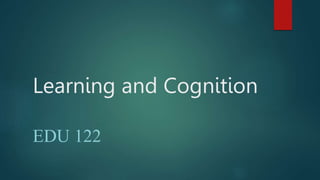
Learning and Cognition (Week4).pptx
- 1. Learning and Cognition EDU 122
- 2. The beautiful thing about life is that you can always change, grow, and get better. You aren’t defined by your past. You aren’t your mistake
- 3. Different Kinds of Smart: Multiple Intelligences
- 5. Intelligence Gardner defines intelligence as a “biopsychological potential to process information that can be activated in a cultural setting to solve problems or create products that are of value in a culture” (Gardner, 2000, p.28).
- 6. “Howard Gardner’s theory of multiple intelligences, gives us a different framework for teaching and thinking in the classroom, as well as how we think about what people do in life. We rely on lots different abilities to succeed in life. Different people have those abilities differently developed, and using the strengths that we have as a pathway into material actually lets us learn that material more deeply.” Linda Darling-Hammond
- 7. What is Multiple Intelligences Theory? Howard Gardner's theory of multiple intelligences proposes that people are not born with all of the intelligence they will ever have. This theory challenged the traditional notion that there is one single type of intelligence, sometimes known as “g” for general intelligence, that only focuses on cognitive abilities.
- 8. Howard Gardner's theory of multiple intelligences To broaden this notion of intelligence, Gardner introduced eight different types of intelligences consisting of: 1. Linguistic 2. Logical/Mathematical 3. Spatial 4. Bodily-Kinesthetic 5. Musical 6. Interpersonal 7. Intrapersonal 8. Naturalist.
- 9. Linguistic Intelligence (“word smart”) Linguistic Intelligence is a part of Howard Gardner's multiple intelligence theory that deals with sensitivity to the spoken and written language, ability to learn languages, and capacity to use language to accomplish certain goals.
- 10. Logical-Mathematical Intelligence (“number/reasoning smart”) Logical-mathematical intelligence refers to the capacity to analyze problems logically, carry out mathematical operations, and investigate issues scientifically.
- 11. Spatial Intelligence (“picture smart”) Spatial intelligence features the potential to recognize and manipulate the patterns of wide space (those used, for instance, by navigators and pilots) as well as the patterns of more confined areas, such as those of importance to sculptors, surgeons, chess players, graphic artists, or architects.
- 12. Bodily-Kinesthetic Intelligence (“body smart”) Bodily kinesthetic intelligence is the potential of using one’s whole body or parts of the body (like the hand or the mouth) to solve problems or to fashion products.
- 13. Musical Intelligence (“music smart”) Musical intelligence refers to the skill in the performance, composition, and appreciation of musical patterns.
- 14. Interpersonal Intelligence (“people smart”) Interpersonal intelligence is the capacity to understand the intentions, motivations, and desires of other people and consequently to work effectively with others.
- 15. Intrapersonal Intelligence (“self smart”) Intrapersonal intelligence is the capacity to understand oneself, to have an effective working model of oneself- including own’s desires, fears, and capacities—and to use such information effectively in regulating one’s own life.
- 16. Naturalist intelligence (“nature smart”) Naturalistic intelligence involves expertise in the recognition and classification of the numerous species—the flora and fauna—of his or her environment.
- 17. Multiple Intelligences in the Classroom Teachers can draw on Gardner’s theory for their classrooms in three ways: 1. By assessing and building on students’ strengths 2. By providing points of entry to subject matter 3. By creating interdisciplinary curricula
- 18. Assessing and Building on Students Strengths In order for students to remain motivated in school, they need opportunities to succeed in learning. An important aim of schooling is to give students opportunities to feel successful. However, students’ preferred mode of intelligence should not become the medium for all of the student’s work in place of developing other needed abilities. Teachers should also be careful to avoid the “pigeon-holing effect” – labeling students forever as “X” types of learners. All individuals possess certain combinations of the various intelligences, and they can apply these differently in different contexts
- 19. Assessing and Building on Students Strengths How can these differing intelligences be assessed? Kreshevsky and Seidel (1998) suggest teachers look for the following things to develop better understandings of individual students: What choices do students make when given options? What roles do they play when working together? How do they handle unanticipated problems? What captures their attention? When do they lose interest? What problem-solving strategies do they offer? How do they communicate ideas, understandings, thoughts, and feelings? What does their physical behavior suggest?
- 20. Providing Powerful Points of Entry Part of being an intelligent learner is demonstrating that you can think about the same idea in different ways. Gardner suggests three ways teachers can enhance students’ understanding: 1. By providing powerful points of entry – many ways to introduce and approach a topic 2. By offering apt analogies – connecting new topics to ideas and concepts that are more readily familiar to students 3. By providing multiple representations of the central or core ideas of the topic